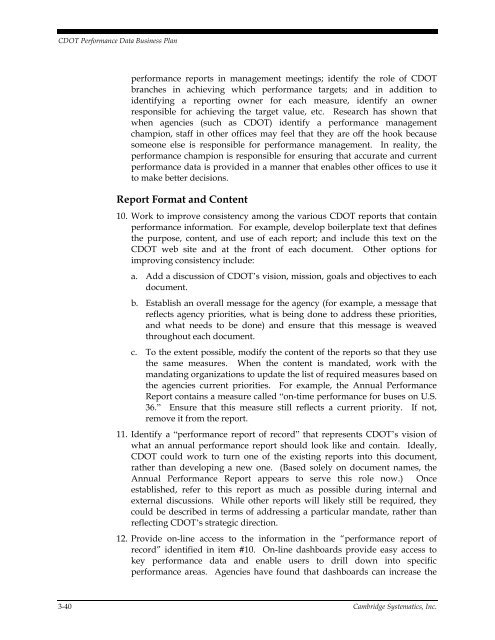CDOT Performance Data Business Plan - Cambridge Systematics
CDOT Performance Data Business Plan - Cambridge Systematics
CDOT Performance Data Business Plan - Cambridge Systematics
Create successful ePaper yourself
Turn your PDF publications into a flip-book with our unique Google optimized e-Paper software.
<strong>CDOT</strong> <strong>Performance</strong> <strong>Data</strong> <strong>Business</strong> <strong>Plan</strong><br />
performance reports in management meetings; identify the role of <strong>CDOT</strong><br />
branches in achieving which performance targets; and in addition to<br />
identifying a reporting owner for each measure, identify an owner<br />
responsible for achieving the target value, etc. Research has shown that<br />
when agencies (such as <strong>CDOT</strong>) identify a performance management<br />
champion, staff in other offices may feel that they are off the hook because<br />
someone else is responsible for performance management. In reality, the<br />
performance champion is responsible for ensuring that accurate and current<br />
performance data is provided in a manner that enables other offices to use it<br />
to make better decisions.<br />
Report Format and Content<br />
10. Work to improve consistency among the various <strong>CDOT</strong> reports that contain<br />
performance information. For example, develop boilerplate text that defines<br />
the purpose, content, and use of each report; and include this text on the<br />
<strong>CDOT</strong> web site and at the front of each document. Other options for<br />
improving consistency include:<br />
a. Add a discussion of <strong>CDOT</strong>’s vision, mission, goals and objectives to each<br />
document.<br />
b. Establish an overall message for the agency (for example, a message that<br />
reflects agency priorities, what is being done to address these priorities,<br />
and what needs to be done) and ensure that this message is weaved<br />
throughout each document.<br />
c. To the extent possible, modify the content of the reports so that they use<br />
the same measures. When the content is mandated, work with the<br />
mandating organizations to update the list of required measures based on<br />
the agencies current priorities. For example, the Annual <strong>Performance</strong><br />
Report contains a measure called “on-time performance for buses on U.S.<br />
36.” Ensure that this measure still reflects a current priority. If not,<br />
remove it from the report.<br />
11. Identify a “performance report of record” that represents <strong>CDOT</strong>’s vision of<br />
what an annual performance report should look like and contain. Ideally,<br />
<strong>CDOT</strong> could work to turn one of the existing reports into this document,<br />
rather than developing a new one. (Based solely on document names, the<br />
Annual <strong>Performance</strong> Report appears to serve this role now.) Once<br />
established, refer to this report as much as possible during internal and<br />
external discussions. While other reports will likely still be required, they<br />
could be described in terms of addressing a particular mandate, rather than<br />
reflecting <strong>CDOT</strong>’s strategic direction.<br />
12. Provide on-line access to the information in the “performance report of<br />
record” identified in item #10. On-line dashboards provide easy access to<br />
key performance data and enable users to drill down into specific<br />
performance areas. Agencies have found that dashboards can increase the<br />
3-40 <strong>Cambridge</strong> <strong>Systematics</strong>, Inc.

















